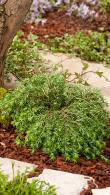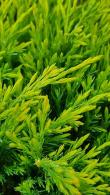Tsuga Heterophylla Thorsens Weeping Western Hemlock
Very Slow-Growing Columnar Pendulous Dwarf Conifer for Shade
1. Add items to basket
2. Go to the basket
3. Enter your postcode in Delivery Price Check
To check delivery cost add your plants to basket, then you can type your postcode in our Quick Delivery Price Check.
Tsuga or Hemlock species are shade-loving evergreen conifers with typically drooping or pendulous branches. Varieties include the Tsuga Canadensis or Eastern Hemlock as well as Tsuga Heterophylla which is the Western Hemlock, native to Western North America along the pacific coast.
Tsuga Heterophylla Thorsen's Weeping, commonly known as Western Hemlock Thorsen’s Weeping or simply Tsuga Heterophylla Thorsen, is a distinctive, compact dwarf conifer valued for its graceful, trailing form and lush evergreen texture. This cultivar combines the characteristic elegance of hemlocks with a refined, dwarf growth habit suited to modern gardens and small landscapes. Its pendulous branches and soft mid-green foliage create a natural cascading effect, adding visual movement throughout the year. A truly individual specimen, Tsuga Heterophylla Thorsen's Weeping offers reliable structure, fine texture, and evergreen appeal for shaded or partially shaded garden settings.
Tsuga Heterophylla Thorsen's Weeping forms a slow-growing, densely branched conifer with a distinctively weeping, almost curtain-like habit. The slender shoots are clothed in short, soft needles that display a rich mid-green hue, maintaining colour and density through all seasons. When allowed to grow naturally, this plant adopts a graceful, ground-hugging form, but it can be trained upright to create a compact, narrow spire with a gentle cascade. New shoots emerge fresh green in spring, deepening through summer, and maintaining vibrancy through autumn and winter. This selection of the Western Hemlock, native to the coastal forests of North America, was introduced around 1985 in the United States. It shares ancestry with other Tsuga Heterophylla forms but distinguishes itself by its diminutive size and refined pendulous habit. Tsuga Heterophylla Thorsen's Weeping partners beautifully with shade-tolerant shrubs such as hydrangea, ferns, and hosta, complementing their broad leaves with fine evergreen texture.
Height and Spread of Tsuga Heterophylla Thorsen's Weeping
Tsuga Heterophylla Thorsen's Weeping grows very slowly, typically reaching a height of around 1.5 m and a spread of 0.5 m after ten years if trained upright. Without staking, it develops a prostrate habit, gently cascading across the ground and forming an attractive, dense mat of green foliage. Its compact stature makes it ideal for smaller gardens, rockeries, and shaded courtyards where space is limited but year-round form is desired.
How Hardy is Tsuga Heterophylla Thorsen's Weeping?
Tsuga Heterophylla Thorsen's Weeping is reliably hardy throughout the UK, tolerating cold and frost once established. It performs best in cool, moist, well-drained soils with a preference for partial shade or dappled light, where its foliage retains the best colour and density. Like other hemlocks, it dislikes drought or exposure to drying winds, so sheltered conditions are ideal. This hardy conifer thrives in humus-rich, slightly acidic soils, making it suitable for woodland gardens or shaded borders with similar moisture-loving companions.
Uses in Garden and Landscape:
Western Hemlock Thorsen’s Weeping is a superb choice for compact gardens, shaded rockeries, and as a specimen in mixed conifer plantings. Its trailing habit offers contrast against upright evergreens, while its weeping branches soften hard landscaping features such as stone walls and paths. Tsuga Heterophylla Thorsen's Weeping pairs attractively with hellebores and Japanese maples, adding year-round texture and evergreen depth. It also enhances woodland-style plantings, blending beautifully with companion plants that prefer cool, moist conditions.
Care Tips:
Plant Tsuga Heterophylla Thorsen's Weeping in autumn or spring into well-prepared, fertile soil enriched with organic matter. Ensure good drainage but maintain consistent moisture during the establishment period. Water regularly in the first year, particularly during dry spells. Apply a balanced fertiliser in spring to promote steady, healthy growth. Light pruning can be carried out after new growth hardens, mainly to refine shape or guide its form when staked. In exposed or windy sites, provide shelter to prevent needle scorch, and mulch annually to conserve moisture and maintain soil acidity.











